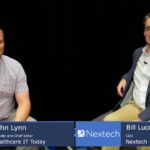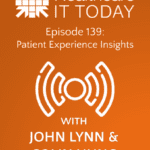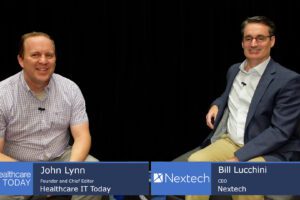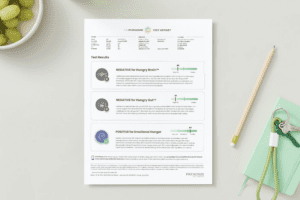The following is a guest interview with Romina Elias, Healthcare Chief Nursing Informatics Officer, and Jeff Kenkel, Global CTO for Life Sciences and Edge at Dell Technologies
The digital transformation of the healthcare industry is on an accelerated path, and part of this change is driven by the multitude of connected devices and sensors available. Smartphones, tablets, two-in-one notebooks, and other connected devices and sensors are now commonplace inside and outside hospitals and clinics, greatly expanding the potential for data-driven solutions that can improve patient care.
A great example of connected devices driving change is their use in remote patient monitoring (RPM), so much so that “88% of providers are investing in RPM solutions to transition to value-based care by supporting high-risk chronically ill patients whose conditions are considered unstable and at risk for hospital admission”.
As more of these smart devices and sensors get connected there are many questions that come to mind, for example, how will this new technology be best used in real life? How will it change the healthcare landscape? How will AI be leveraged to deliver actionable insights from all this new data? And how can we make sure these devices are affordable, scalable, secure, and can interconnect with current healthcare technologies such as EMRs? How can we ensure patients’ privacy with all the devices and sensors transmitting data?
Let’s explore some of these key questions with two of Dell Technologies’ subject matter experts in these topics, Romina Elias, Healthcare Chief Nursing Information Officer and Jeff Kenkel, Global Chief Technology Officer, Life Sciences and Edge.
Real-World Use of Edge Devices in Healthcare and Life Sciences
John: Romina, please tell us what you think about the rise of connected devices and sensors in healthcare and life sciences.
Romina: The rise of connected devices in healthcare was foreshadowed by the consumerization of healthcare in the ‘90s and ‘00s. Digital services and technologies for personal use increased, prompting the healthcare industry to modernize its services and technologies to meet consumer demands. This has led to the development of technology for personalized care delivery, such as web-based applications for personal health records and personal device integration for capturing medical information. The demand for digital services has also driven the integration of smartphone apps and wearable devices for capturing vital data, enabling care providers to monitor patient data remotely and allowing consumers to manage their own health with access to data.
John: Jeff, anything to add from your perspective?
Jeff: Yes, thank you.
Advanced sensor technology in edge-connected devices has enabled their use inside and outside traditional clinical care settings, particularly in chronic disease management. For instance, these devices can capture a patient’s blood glucose every 5 minutes with greater accuracy, alerting the patient or care provider immediately if it falls within a dangerous range. These devices can also deliver and control insulin therapy based on the captured glucose measurements and other data, leading to improved glucose control and preventing complications. This AI-supported, personalized disease management approach uses edge-captured data to deliver better insights, improved therapy protocols, and drive innovation for longer and healthier lives.
How else are these Edge Devices and Data Changing the Landscape for the Healthcare Industry?
John: We see how expanded internet connectivity and now 5G technologies have opened the door for “healthcare” organizations (the definition of a healthcare organization is evolving before our eyes) to collect and process data at an incredible scale. Romina can you share with us how you see this new data impacting the landscape of the industry?
Romina: Big Data has the potential to revolutionize healthcare by enabling tailor-made treatment plans, predicting and preventing medical complications, and allowing targeted outreach to patients. Its promising applications include accurate patient identification, risk management, and population health. Accurate patient identification reduces errors and duplicative treatments, risk management tools predict potential issues and allow proactive preventative treatment, and population health tools monitor large groups and assist medical professionals in tailoring treatment plans.
Jeff: The examples Romina shared illustrate the intelligent use of ‘active data’. And, while edge-connected devices allow clinicians to capture real-time patient data they’ve not had access to before, the true power of active data comes from combining it with other sources through data management and AI.
However, healthcare and life sciences data sets aren’t always complete, error-free, or in a format that can be easily combined. Data sets require modern tools to cleanse and wrangle them for clinical understanding and research insights. Data management is a journey, and quality management takes time, but with the right tools, valuable insights can be surfaced, even for large and varied healthcare and life sciences data sets. Graph technology can help examine, contextualize, and visualize key relationships.
Data and AI Delivering on the Promise of Edge Devices
John: I see how these edge devices are really making a difference, thank you both. But this brings up an important question, how do you see hospitals leading with all this new data? What tools do they have to best leverage all this new patient information?
Romina: As Jeff mentioned, unlocking the potential of ‘active data’ is the key to delivering its value in healthcare. Intelligence garnered through synthesis of data allows for personalized care delivery, proactive healthcare management and operational efficiency with the use of AI. AI allows healthcare organizations to process and analyze data at an unprecedented scale and detect patterns and anomalies humans might miss in other ways, and even enable the development of predictive algorithms that alert clinicians to potential adverse outcomes.
AI is already being used to identify patients at risk for certain diseases and improve patient identification, as well as to detect and predict potential issues such as the onset of a heart attack, allowing medical professionals to proactively prescribe preventative or interventional treatment. However, there are still challenges to be overcome in terms of data quality and standardization, as well as ethical and privacy concerns.
John: These developments are remarkable – thank you, Romina. Jeff, what do you think? How do you see AI being leveraged in healthcare today or what issues are there and how can it also impact the future of care?
Jeff: We are continuing to see more and more acceptance and success with edge devices and AI, but Edge devices and AI in healthcare are in the early stages of evolution, with exciting advancements expected in the next 5-10 years and beyond, especially with the advancement of high-performance and Quantum compute. To be widely adopted, the value of the technology and AI needs to be demonstrated and validated for clinicians and researchers.
And we are already seeing this. As we talked about earlier, the use of edge technology is helping to manage type 1 diabetes and is changing people’s lives for the better. The technology, including active data capture at the point of patient, data management and the AI are delivering both immediate and long-term value for both patients and their care providers. Not tomorrow, but today, and this is but one of numerous promising indicators for the future of care.
Conclusion
John: Thank you both Romina and Jeff for your insights. Would you like to share any final thoughts on this topic?
Romina: The digital transformation of healthcare is an ongoing process, and the emergence and integration of edge-connected devices and AI in healthcare is a crucial milestone in this journey. As healthcare organizations invest more in AI, the technology is expected to become more reliable and accurate. The adoption of edge-connected devices and AI will lead to an increase in available data, enabling healthcare organizations to make better decisions, offer personalized treatment plans, and reduce preventable deaths. The future of healthcare looks promising with these advancements, and we can expect to see even more progress in the coming years.
Jeff: The full extent and impact that edge-connected devices and AI will have on healthcare and life sciences is yet to be fully realized. However, we are already seeing the changes it brings when thoughtfully implemented. As we explore more ways to use these exciting new technologies, and for the technologies to have the greatest impact, we need to make sure the solutions are: (1) accessible to all patients who might need them, (2) are secure so organizations can deploy the solutions effectively, and (3) securely connected so the active-data can continue to inform researchers to better understand disease and develop new therapies and clinicians who are striving to provide the best care possible for their patients.
By combining active patient data sources with edge-connected active data and expertise, we can deliver advanced care and therapy to patients and populations. With continued exploration and implementation of these technologies, we can look forward to improving health outcomes and transforming the healthcare landscape.
More to Consider
- AI aims to replicate human actions more efficiently, but errors can still occur.
- Algorithms using faulty data can result in inconsistent outcomes.
- High-quality training data that accurately reflects real-world scenarios is crucial to produce models that generalize well and avoid errors.
- Data and algorithms must be tailored to specific use cases and organizations to fully benefit from AI.
- Proper governance is necessary to ensure AI models improve patient care as intended.
- Privacy-enhancing techniques and technologies that avoid unintended bias or errors must be used to protect PHI and PII, potentially including secure enclaves with appropriate certifications.
 About Romina Elias
About Romina Elias
Romina Elias is the Chief Nursing Informatics Officer Dell Technologies. A nurse by trade, she has over 17 years of healthcare experience. Prior to joining Dell, Romina was a Nursing Executive where she drove quality outcomes and patient experience results by developing efficient processes in healthcare delivery. Her team received the prestigious Beacon Gold award for clinical excellence as well as the Guardian of Excellence Award for outstanding patient experience 3 years in a row. Romina is an advocate of furthering the nursing profession through education and has mentored several nurses through their pursuit of advanced degrees. She has a passion for patient care and healthcare IT motivates her to help deliver technologies that would positively impact both clinicians and patients alike.
 About Jeff Kenkel
About Jeff Kenkel
Jeff Kenkel is the Global CTO for Life Sciences and Edge at Dell Technologies. He has over 30 years of product and technology solution development experience working with a variety of businesses from start-ups to Fortune 50 enterprise customers. He has led strong and talented cross-functional teams to deliver solutions with high-value outcomes, some achieving industry recognition. Prior to Dell Technologies, Jeff served as CTO, Health and Life Sciences, and as a Hitachi Group Brand Ambassador, where he was responsible for Hitachi Vantara’s Healthcare and Life Sciences Solutions. Jeff is keenly interested in advancing patient, clinician and research outcomes, and believes the most effective solutions use technology to enhance the human experience.
Dell Technologies is a proud sponsor of Healthcare Scene.













